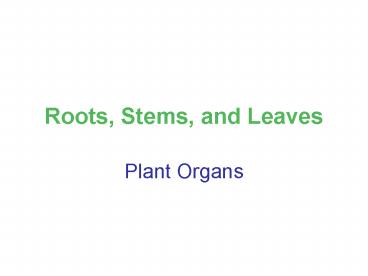Roots, Stems, and Leaves - PowerPoint PPT Presentation
1 / 18
Title:
Roots, Stems, and Leaves
Description:
covered with waxy cuticle that protects against water loss. Vascular: *xylem and phloem carry water and nutrients through the plant ... – PowerPoint PPT presentation
Number of Views:115
Avg rating:3.0/5.0
Title: Roots, Stems, and Leaves
1
Roots, Stems, and Leaves
- Plant Organs
2
- Roots Absorb water and nutrients
- Anchor plants in ground
- Stems support plant body
- transport nutrients among plant parts
- Leaves carry out photosynthesis
- funnel water to roots exchange sites for
oxygen and carbon dioxide
3
Root, Stem, and Leaf Tissues
Section 23-1
Leaf
Stem
Root
Dermal tissue Vascular tissue Ground tissue
4
Tissue Systems
- Dermal outer covering of plants
- single layer of epidermal cells
- covered with waxy cuticle that protects
against water loss - Vascular xylem and phloem carry water and
nutrients through the plant - Ground parenchyma, collenchyma,
schlerenchyma, support the plant and site
of photosynthesis - Meristematic only in tips of shoots and roots,
responsible for plant growth
Page 581
Page 582
Page 583
Page 580
5
Fibrous Roots vs. Taproots
- Fibrous roots are shallow and wide-reaching
- Taproots are DEEP and concentrated downwards
See pages 584-585 in text
6
Figure 35.14 Primary growth of a root
7
Water Transport in a Root
Section 23-2
Epidermis
Endodermis
Cortex
Casparian strip
Cell wall
Root hairs
Cell membrane
Cortex
Phloem
Active transportof minerals
Xylem
Movement of water by osmosis
VascularCylinder
8
Figure 35.3 Radish root hairs
9
Figure 35.18 Organization of primary tissues in
young stems
10
Layers of a Tree Trunk
Section 23-3
Wood
Bark
Cork
XylemHeartwood
Cork Cambium
Phloem
Vascular Cambium
Xylem Sapwood
11
Stem adaptations
- See page 594
- Tuber stem growing underground (potato)
- Bulb central stem surrounded by leaves
- (amaryllis)
- Corm thickened stem that stores food
(gladiolus) - Rhizome horizontal, underground stem
- (ginger)
12
Figure 35.5 Simple versus compound leaves
13
The Internal Structure of a Leaf
Section 23-4
Cuticle
Veins
Epidermis
Palisademesophyll
Xylem
Vein
Phloem
Spongymesophyll
Epidermis
Stoma
Guardcells
14
Transpiration
Section 23-5
A
B
Evaporation of water molecules out of leaves.
Pull of water molecules upward from the roots.
15
Function of Guard Cells gas exchange (CO2 in,
O2 out)
Section 23-4
Guard cells
Guard cells
Inner cell wall
Inner cell wall
Stoma
Stoma Open
Stoma Closed
16
Figure 35.6 Modified leaves Tendrils, pea plant
(top left) spines, cacti (top right) succulent
(bottom left) brightly-colored leaves,
poinsettia (bottom right)
17
Water tranport
- Capillary action water moves upward through
narrow tubes against the force of gravity
(adhesion and cohesion)
18
Food Transport
- Movement from source (where sugars are produced
by photosynthesis) in leaves to - where sugars are used or stored































